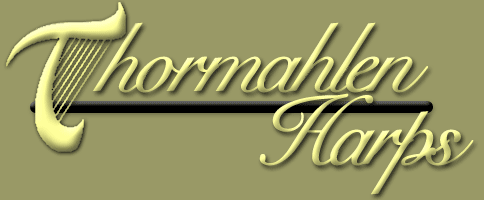| Regulating
Camac Levers
The great thing about Camac levers is that the player can
easily regulate them. I rarely attempted to regulate my harp with any
other lever, but with the Camacs, I am very confident that I can do
it and so can you.
Here
are instructions for regulating your harp with Camac Levers. Here are
two videos to watch:
 Your
tool kit ($25) contains the following: Your
tool kit ($25) contains the following:
• 1 smaller 5/64” L wrench for the higher strings
• 1 larger 3/32” L wrench for the lower strings
• #8 torx driver for use on all the levers where they connect
to the neck
• These instructions.
To regulate your entire harp, first, connect your harp to a tuner.
Tune the low C, then lever the note and play the C string again as a C#. If the
levered C# note registers in the same spot on your tuner as the open note, then
move on to the next string (D).
If the levered C# note is flat, use your larger
L wrench to turn the bridge pin counter clockwise. This will raise
the pitch of the levered note. Check the pitch and if it’s still
flat, turn the bridge pin a little more.
If the levered C# note is sharp, turn the bridge pin clockwise to
lower the pitch of the levered note.
Continue moving up the harp in this manner. About 1/2 way up the strings,
where the bridge pins get smaller, use the smaller L wrench.
If you're just regulating one string, of course, just play that particular
string.
Here is some helpful information:
The bridge pins are threaded, so as you turn the bridge pin counterclockwise,
the pin twists out from the neck. As you turn the pin clockwise it
goes further into the neck.
You will need to turn the bridge pin a larger amount for the lower notes
and smaller amount for the highest notes to make a difference in the
pitch of the string.
You will need to engage the lever of the very highest strings to access
the bridge pin.
If you have to turn the pin so much that the string then is too close
to the lever and buzzes on the lever parts recenter the bridge
pin approximately to where it was before it buzzed.
Then using the torx driver, loosen the screws that hold the lever onto
the neck but don’t remove them; just barely loosen them.
If the levered note was flat, you’ll want to slide the lever down
a little bit. If the levered note was sharp, you’ll want to slide
the lever up a little bit. Make sure you keep the lever straight up
and down.
Tighten the screws just enough to hold the lever to the neck but not
so much that you break the screw. Then re-regulate the harp using
the L wrenches to adjust the bridge pin and
regulate the note.
 This
top picture shows the black bridge pins with the hole in the middle
and will need the regulating kit on this page. The picture below shows
the silver hexagonal bridge pins and will need the other
regulating kit. This
top picture shows the black bridge pins with the hole in the middle
and will need the regulating kit on this page. The picture below shows
the silver hexagonal bridge pins and will need the other
regulating kit.

About Camac Levers
"The lever tool kit arrived in my mailbox yesterday. After taking
a look at it, I decided to see what I could do. Oh.... that was easy...Actually,
it didn't feel as if I moved the little screw at all... but I must
have, because the bracket stabilized and the problem is solved I also
applied the tool to the G next to the errant A, and stabilized that
one, too. I'm so glad you encouraged me to try it myself! Thank you!"
Carol Snyder, Arizona
 Go
on to the strings page
or back to the page on
levers . Go
on to the strings page
or back to the page on
levers .
|

 Your
tool kit ($25) contains the following:
Your
tool kit ($25) contains the following:
 This
top picture shows the black bridge pins with the hole in the middle
and will need the regulating kit on this page. The picture below shows
the silver hexagonal bridge pins and will need the
This
top picture shows the black bridge pins with the hole in the middle
and will need the regulating kit on this page. The picture below shows
the silver hexagonal bridge pins and will need the 